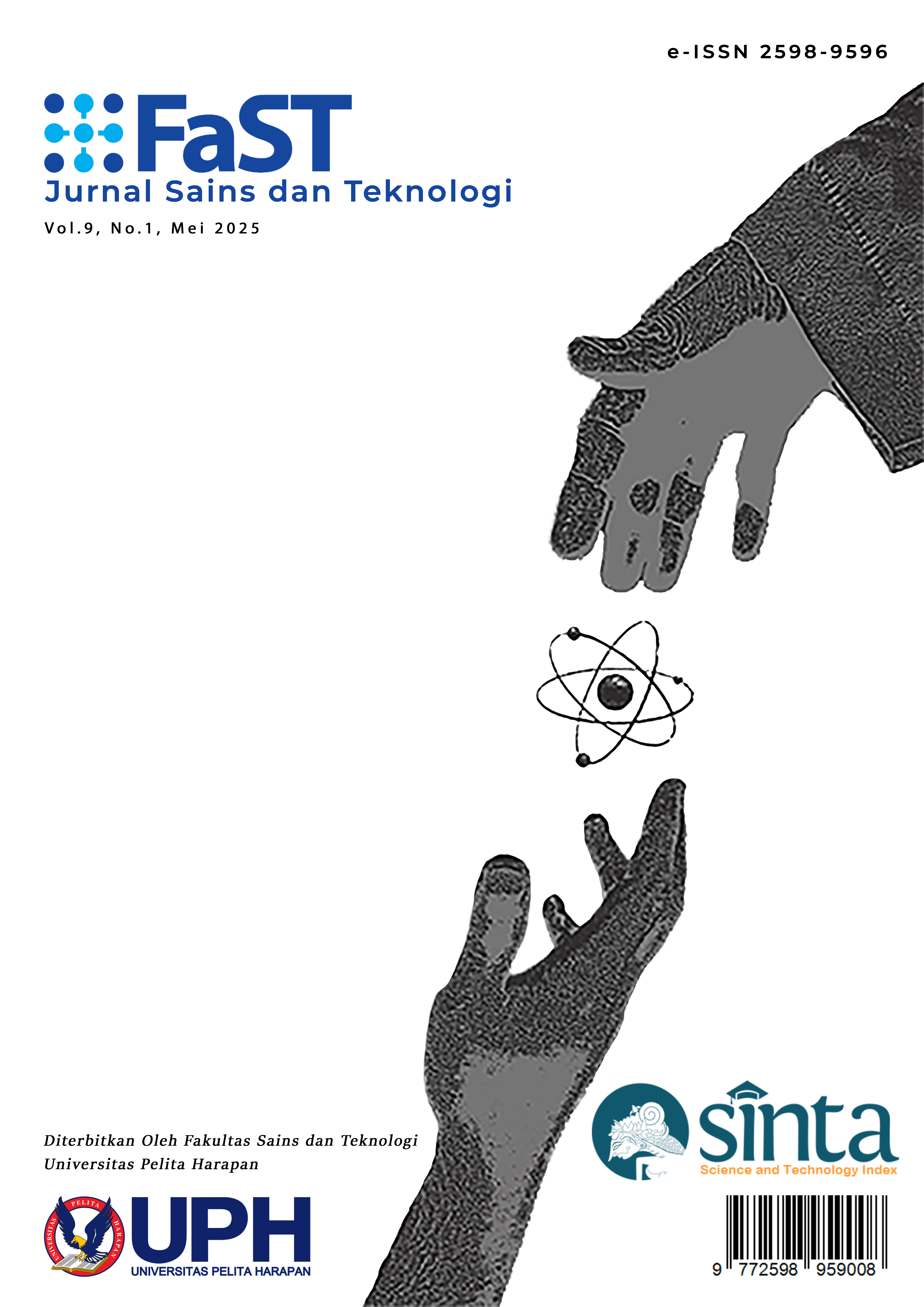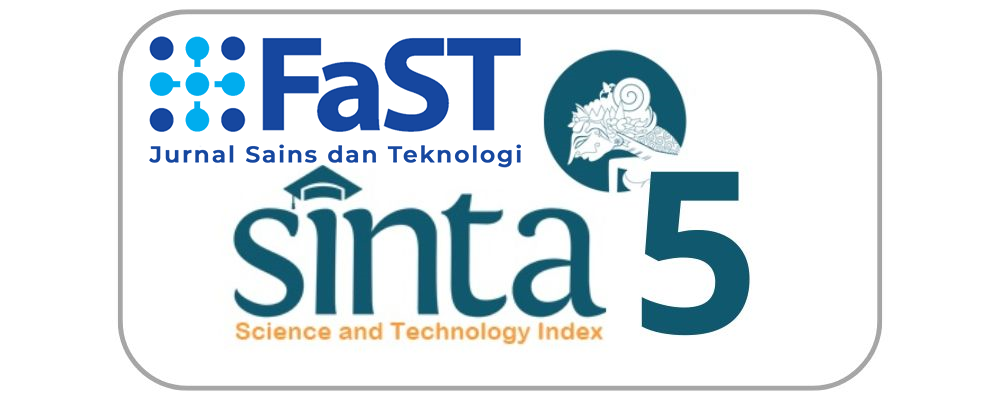Modifikasi Sistem Cutting Body Ply pada Mesin Building Menggunakan PLC Allen-Bradley
[Modification of Bodyply Cutting System on Building Machines Using Allen-Bradley PLC]
DOI:
https://doi.org/10.19166/jstfast.v9i1.9661Keywords:
Body ply cutting, VFD, PLC, Allen-Bradley, OtomatisasiAbstract
The process of body ply cutting system was previously performed manually, resulting in high cycle time and safety risks. The main issues include the lack of standardization in cutting pressure, cutting speed, and the risks associated with using a blade heated to 160-180°C. The proposed automated solution involves implementing proximity sensors, a Variable Frequency Drive (VFD), pneumatic solenoids, a three-phase motor, and a heating system with temperature control using a thermocouple. The system is controlled using an Allen-Bradley PLC and programmed with Studio 5000 Logix Designer. The results indicate that the modifications successfully reduce the cycle time per unit by 9.11% and increased production in the first shift by 7.6%.
Bahasa Indonesia Abstract: Proses body ply cutting sebelumnya dilakukan secara manual, menyebabkan tingginya cycle time dan risiko keselamatan kerja. Beberapa masalah utama yang terjadi adalah tekanan pemotongan yang tidak standar, kecepatan pemotongan, dan risiko penggunaan pisau yang dipanaskan hingga 160-180°C. Solusi yang diusulkan adalah otomatisasi proses mencakup penerapan sensor proximity, Variable Frequency Drive (VFD), solenoid pneumatik, motor 3 fasa, serta pemanas dengan pengendalian suhu menggunakan termokopel. Sistem ini dikontrol menggunakan PLC Allen-Bradley dan diprogram melalui Studio 5000 Logix Designer. Hasil penelitian menunjukkan bahwa modifikasi ini berhasil mengurangi cycle time/unit sebesar 9,11% dan meningkatkan produksi pada shift 1 sebesar 7,6%.
References
Prakoso, G. (2020). Modifikasi Sistem Carcass Stitcher Pada Mesin Building Menggunakan PLC Siemens Simatic S7-300 [Laporan Tugas Akhir]. Fakultas Teknik, Universitas Mercubuana, Jakarta.
Rais, M. H., Awad, R. A., Lopez, J., & Ahmed, I. (Apr 2022). Memory Forensic Analysis Of A Programmable Logic Controller In Industrial Control Systems, Forensic Science International: Digital Investigation, Commonwealth University, vol. 40. https://doi.org/10.1016/j.fsidi.2022.301339.
Nugraha, A. T., Marjuki, R., Agna, D. I. Y., & Ivannuri, F. (Mei 2023). Sistem Kontrol Tegangan pada Generator Induksi 3 Phasa dengan PLC Voltage, Elektriese: Jurnal Sains dan Teknologi Elektro vol. 13 no. 01, 21–33. https://doi.org/10.47709/elektriese.v13i01.2347
Agamloh, E. B. (2017). Power and Efficiency Measurement of Motor-Variable-Frequency Drive Systems, IEEE Transactions on Industry Applications, vol. 53 no. 1, 766-773. https://doi.org/10.1109/TIA.2016.2602807.
Yadav, G., & Paul, K. (2021). Architecture and security of SCADA systems: A review, International Journal of Critical Infrastructure Protection, vol. 34. https://doi.org/10.1016/j.ijcip.2021.100433.
Thepmanee, T., Pongswatd, S., Asadi, F., & Ukakimaparn, P. (Apr 2022). Implementation of control and SCADA system: Case study of Allen Bradley PLC by using WirelessHART to temperature control and device diagnostic, Energy Reports vol. 8, 934–941. https://doi.org/10.1016/j.egyr.2021.11.163.
Steven, H., Nabihah, A. R., Sherina, T., Dwiyaniti, M., Indriyani, S., & Widjajanto, D. (2022). Implementasi PLV-VSD dan SCADA pada sistem pengisian air otomatis, Electrices vol. 4 no. 2. https://doi.org/10.32722/ees.v4i2.4679.
Prasetia, A. M., & Santoso, H. (July 2018). Implementation Of Scalar Control Method For 3 Phase Induction Motor Speed Control, Elinvo (Electronics, Informatics, and Vocational Education) vol. 3 no. 1, 63–69. https://doi.org/10.21831/elinvo.v3i1.19460.
Mourtzis, D., Angelopoulos, J., & Panopoulos, N. (April 2023). The Future of the Human–Machine Interface (HMI) in Society 5.0, MDPI, Future Internet 15(5) 162. https://doi.org/10.3390/fi15050162.
Sirait, B. B., Nachrowie, Suprayogi. (2024). Rancang Bangun Penegang Baji Tutup Meriam 57mm/S-60 Berbasis Arduino Uno Dan Sensor Proximity. Seminar Nasional Fortei Regional 7, vol. 1 no. 1.
Downloads
Published
Issue
Section
License
Copyright (c) 2025 Mario Gracio Anduinta Rhizma, Denson Siburian, Henri Uranus

This work is licensed under a Creative Commons Attribution-ShareAlike 4.0 International License.
“Authors who publish with this journal agree to the following terms:
1) Authors retain copyright and grant the journal right of first publication with the work simultaneously licensed under a Creative Commons Attribution License (CC-BY-SA 4.0) that allows others to share the work with an acknowledgement of the work's authorship and initial publication in this journal.
2) Authors are able to enter into separate, additional contractual arrangements for the non-exclusive distribution of the journal's published version of the work (e.g., post it to an institutional repository or publish it in a book), with an acknowledgement of its initial publication in this journal.
3) Authors are permitted and encouraged to post their work online (e.g., in institutional repositories or on their website). The final published PDF should be used and bibliographic details that credit the publication in this journal should be included.”



